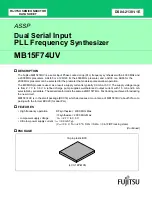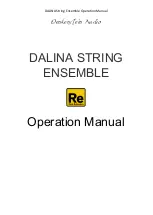
2
Minimax
Introduction
What’s the Max about the
Mini?
Just what is it about the Minimax?
Today you would probably not expect too
much in terms of sound from a
synthesizer with 3 oscillators and noise,
a mixer, followed by a filter with an
amplifier and two envelope generators.
But we’re not talking about just any
synthesizer, we’re talking about
the
synthesizer!
Minimax is an emulation of the probably
best-known of all vintage synths. It’s sim-
ple structure makes it easier to learn
sound creation techniques than on many
other synthesizer models. And its sound
is famous. The oscillators are strong and
powerful, the filter pack and envelope
generators blindingly fast.
Many have tried to duplicate these
characteristics. However, attempts by
both hardware and software
manufacturers have failed. With hardware,
the different electronic components often
used changed the sound. And in software
only some parts of the original, such as
the filter, were successfully emulated.
Other elements, like the oscillators and
envelopes, were imported from outside
sources.
CreamWare knows how difficult a true
emulation is. From today’s perspective,
the Miniscope and Miniscope MkII must
be considered as great synthesizers in
their own right, but not as emulations of
the original.
Minimax is different than anything that’s
come before. Minimax does not just
emulate parts of the instrument - Mini-
max
is the instrument. Where there have
been limits to the hardware, such as ori-
ginal components no longer being
available, and where software has not
dared to go, there goes Minimax.
With the Minimax we modeled all
important sound elements on the origi-
nal circuit diagrams. And throughout the
process we constantly recalibrated our
design to conform with the original so
that even the positions of the controls
agree. Still the reproduction was not
exact. Calibration and adjustment was
only part of the work we had to do.
We had yet another hurdle to jump before
we could claim success. The original
synth produces frequencies that, had we
relied on the usual algorithms, would
have led to aliasing. And those familiar
with aliasing know what an unpleasant
noise it is to have in a signal. The
modules used in the Minimax are built
on newly-developed algorithms free from
aliasing. For this reason Minimax easily
handles even the wildest filter, FM, or
oscillator modulations. And the beauty
of it is - Minimax always sounds like the
original. Minimax represents the
pinnacle of synthesis algorithm
development.




























